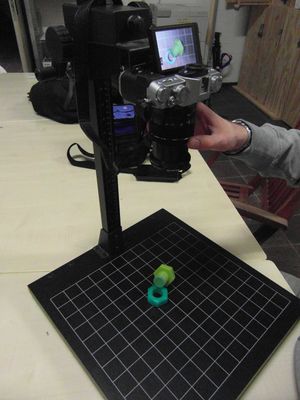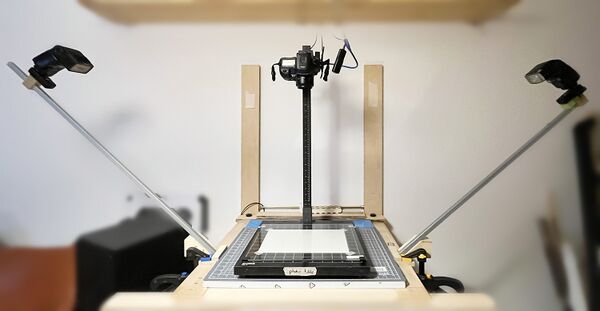Copy Stand: Difference between revisions
m (Lukas moved page Photo Table to Copy Stand) |
No edit summary |
||
| Line 15: | Line 15: | ||
|similar= | |similar= | ||
}} | }} | ||
We have a small copy stand for taking '''reproducible photos''' of | We have a small copy stand for taking '''reproducible photos''' (repro-copies) of two-dimensional originals. Any camera with a standard 1/4" thread should be compatible with it. | ||
You can find it in the [[Common Room|common room]]. | You can find it in the [[Common Room|common room]]. | ||
To produce high-quality reproductions, you'll need two identical lightsources (for example flashguns, or daylight bulbs). Flashguns are ideal, as they allow for a short shutter speed (usually 1/200 or faster), so any other light sources in the room won't show in your final repro-photo. | |||
The two light sources should have: | |||
* the same strength/power (flashguns are ideal, as their power can easily be adjusted when in manual mode). | |||
* identical angle and distance to the centre of the copy stand surface | |||
* angles around 25-50° are ideal; if the angle is too high, light (hotspots) can reflect back into the camera | |||
* the same colour temperature (ideally daylight, so colours get reproduced correctly) | |||
If you don't have access to two identical light sources, the next best thing would be to use the copy stand indoors, or in a shady location. In other words: not in direct sunlight. Ideal circumstances in this case would be: | |||
* indirect light (shade, indoors) | |||
* not too close to a wall (even if you're indoors: light reflects back from walls – worst case would be a coloured wall) | |||
* not too close to a window (due to light fall-off) | |||
* window pointing away from the copy stand's column (so it doesn't cast a shadow) | |||
* use a cable release (or timer), so to avoid camera shake (indoors without flash, your exposure times will likely be long enough to be prone to camera shake) | |||
For best results, it's recommended to set your camera to shoot in RAW format – this is particularly important when you're not using flashguns. If your camera doesn't support RAW format, try setting it to custom white balance whilst pointing it towards a white wall or piece of paper. | |||
Here's a sample setup with two flashguns – both at the same distance and at 45° angle to the surface. | |||
[[File:Copy stand with 2 flashguns.jpg|left|frameless|600x600px]] | |||
In the above picture, the two flashguns are different brand. This is totally fine, as long as you can trigger them simultaneously – either via a photocell trigger, two sync cables, or in this case an wireless electronic trigger. | |||
To check if your two flashguns have the same strength, you can take two test images of a white piece of paper (one flash off, the other on) and compare them. If the intensity and light fall-off look the same to you, it'll be fine. | |||
== Upgrade Ideas == | == Upgrade Ideas == | ||
Revision as of 15:43, 9 February 2024
| ToolInfoBox Copy Stand | |
|---|---|

| |
| Synonyms: | DE: Reprostativ, Kameraständer, Reproständer, Reprostand |
| Type: | camera stand |
| Used with: | camera |
| Location: | common room |
We have a small copy stand for taking reproducible photos (repro-copies) of two-dimensional originals. Any camera with a standard 1/4" thread should be compatible with it.
You can find it in the common room.
To produce high-quality reproductions, you'll need two identical lightsources (for example flashguns, or daylight bulbs). Flashguns are ideal, as they allow for a short shutter speed (usually 1/200 or faster), so any other light sources in the room won't show in your final repro-photo.
The two light sources should have:
- the same strength/power (flashguns are ideal, as their power can easily be adjusted when in manual mode).
- identical angle and distance to the centre of the copy stand surface
- angles around 25-50° are ideal; if the angle is too high, light (hotspots) can reflect back into the camera
- the same colour temperature (ideally daylight, so colours get reproduced correctly)
If you don't have access to two identical light sources, the next best thing would be to use the copy stand indoors, or in a shady location. In other words: not in direct sunlight. Ideal circumstances in this case would be:
- indirect light (shade, indoors)
- not too close to a wall (even if you're indoors: light reflects back from walls – worst case would be a coloured wall)
- not too close to a window (due to light fall-off)
- window pointing away from the copy stand's column (so it doesn't cast a shadow)
- use a cable release (or timer), so to avoid camera shake (indoors without flash, your exposure times will likely be long enough to be prone to camera shake)
For best results, it's recommended to set your camera to shoot in RAW format – this is particularly important when you're not using flashguns. If your camera doesn't support RAW format, try setting it to custom white balance whilst pointing it towards a white wall or piece of paper.
Here's a sample setup with two flashguns – both at the same distance and at 45° angle to the surface.
In the above picture, the two flashguns are different brand. This is totally fine, as long as you can trigger them simultaneously – either via a photocell trigger, two sync cables, or in this case an wireless electronic trigger.
To check if your two flashguns have the same strength, you can take two test images of a white piece of paper (one flash off, the other on) and compare them. If the intensity and light fall-off look the same to you, it'll be fine.
Upgrade Ideas
- lights (could be wired through the extra holes in the back)
- optional white background
- 3D printed "quick mounts"
